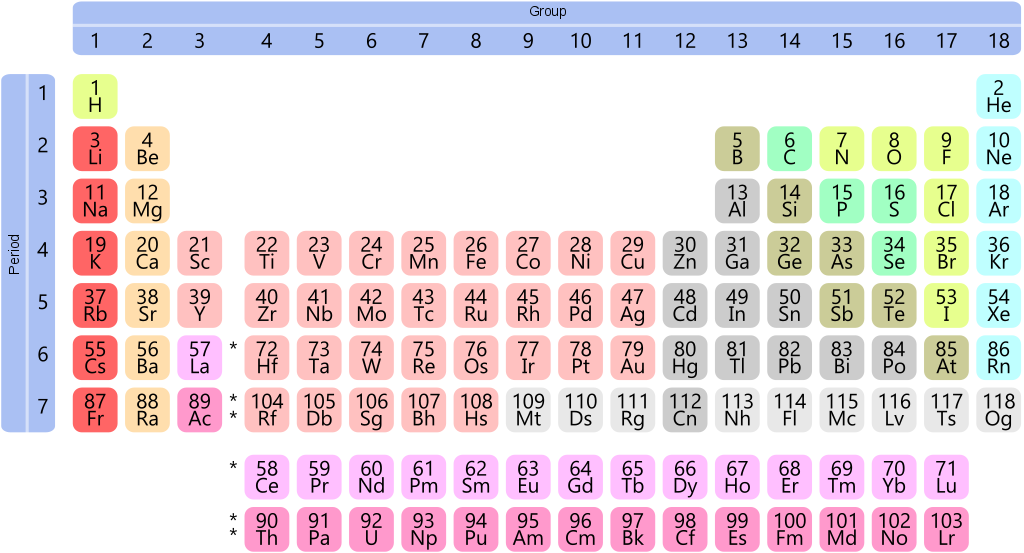3. From Atoms to Stars to Atoms
Summary A few hundred million years after the Big Bang some gas clouds collapsed due to their gravitational self-attraction and formed the first stars, astronomical bodies like the Sun. Lightweight atomic nuclei are fused to heavy atomic nuclei in the cores of stars, in particular hydrogen to helium, and the resulting energy from that process lets stars light up the Universe. The nuclear evolution brought about by stars laid the foundation for the subsequent chemical evolution in the interstellar medium and on Earth, leading to complex molecules and ultimately to life.
Keywords Atoms; Chemistry; Interstellar Medium; Nuclear Fusion; Stars

The Omega Nebula, a star formation region in the Milky Way at a distance of 5000 light-years from Earth. The red color originates from hydrogen clouds which were partially ionized by the intense radiation of young stars. (© ESO / Wikimedia Commons / CC-BY-4.0)
After the Universe had become transparent 380,000 years after the Big Bang, it entered the Dark Ages, as apart from the Cosmic Microwave Background nearly nothing was to be seen. As the hydrogen-helium gas clouds in the Universe cooled further, a few hundred million years after the Big Bang for some of them the gravitational self-attraction became dominant and led to collapse. As the gas clouds collapsed, their cores became hotter and denser until the conditions for nuclear fusion were met. This led to the birth of the first stars, which are defined as being astronomical bodies in whose cores the fusion of atomic nuclei takes place. This process is also called stellar nucleosynthesis. Stars gained new equilibria as the radiation outward pressure, which is due to nuclear fusion, now balanced the gravitational inward pressure, which had caused the gas cloud collapse in the first place.
Stars today constitute the majority of the astronomical bodies which are visible at the night sky. Also the Sun is a star, with the only difference that it is much closer to Earth than all other stars, which results in it having a much larger apparent brightness. While the equivalency of the Sun and stars had been suggested by ancient Greek philosophers more than 2000 years ago, it only became undoubtful in the 19th century when the distances to stars could be measured for the first time. After the creation of the first stars and within the first billion years after the Big Bang, due to the energetic stellar radiation the hydrogen-helium clouds between the stars, which is called the interstellar medium, were largely re-ionized. However, even though the probability of photons being absorbed in the newly created plasma was much bigger than before, the Universe had already expanded so much that it remained largely transparent.

The periodic table of elements. Apart from the first two elements hydrogen (H) and helium (He), the majority of elements was fused in the cores of living stars or during explosions of dying massive stars. (© User:Offnfopt / Wikimedia Commons / Public Domain)
The stars not only lighted up the Universe and re-ionized most of the interstellar medium, they also enriched the Universe with significant amounts of elements heavier than helium, and such filled the periodic table of elements. This nuclear evolution laid the foundation for the subsequent chemical evolution in the interstellar medium and on Earth, leading to complex molecules and ultimately to life. While the nuclear fusion of hydrogen (H) to helium (He) is the energy source during most of the lifetime of a star, including for the Sun since its birth and for some billions of years to come, in the later stages of its existence also heavier nuclei are incubated in a star’s core, such as carbon (C), neon (Ne), oxygen (O) or silicon (Si). Stellar nucleosynthesis occurs up to iron (Fe) which has 26 protons, beyond which nuclear fusion becomes energetically unfavorable. Heavier elements than iron, for example gold (Au) or uranium (U), are synthesized in exploding massive stars, a process which is called supernova nucleosynthesis. Complex molecules formed in the interstellar medium which had been enriched by heavy elements, such as water (H2O), methane (CH4) or organic molecules like formaldehyde (CH2O) or ethanol (C2H5OH).
Dependent on its mass, after all nuclear fuel is used up in its core, a star finally dies and ends up as a white dwarf, a neutron star or a black hole, with white dwarfs being the ultimate fate of low-mass stars, such as the Sun, and black holes being the final stage of high-mass stars. While in the first two star remnant types the gravitational self-attraction is halted by pressures which have their origins in quantum mechanics, the so-called degeneracy pressures, there is no known stabilization mechanism for black holes, which collapse to a single massive point in space.
